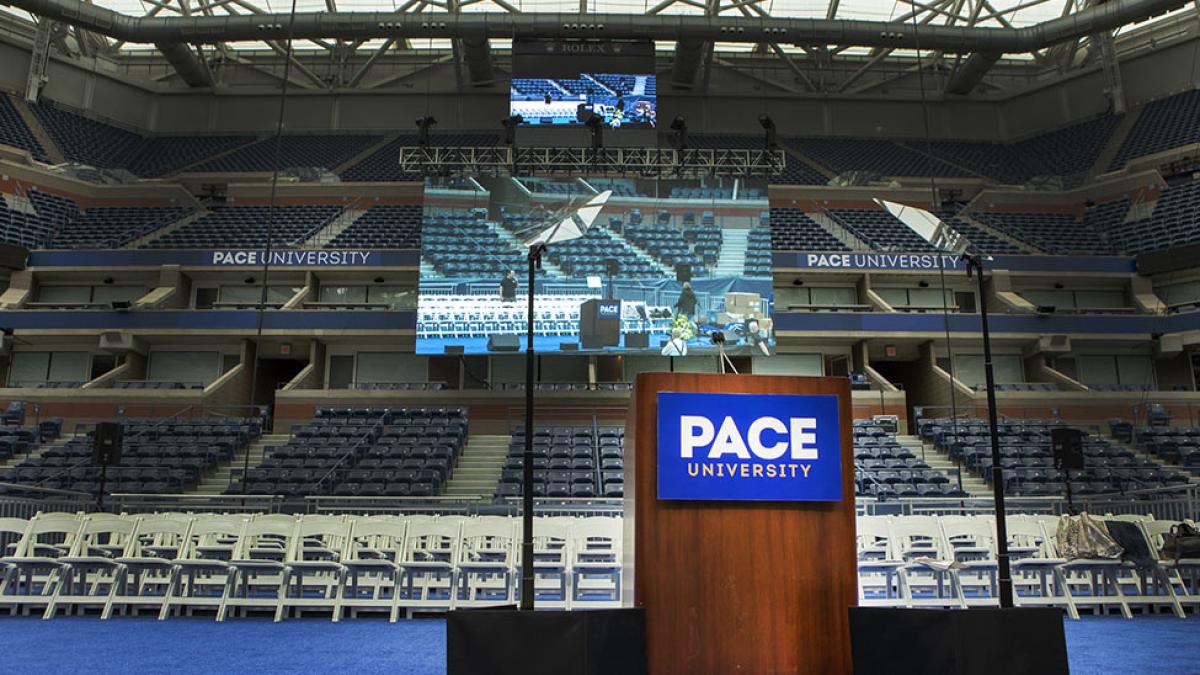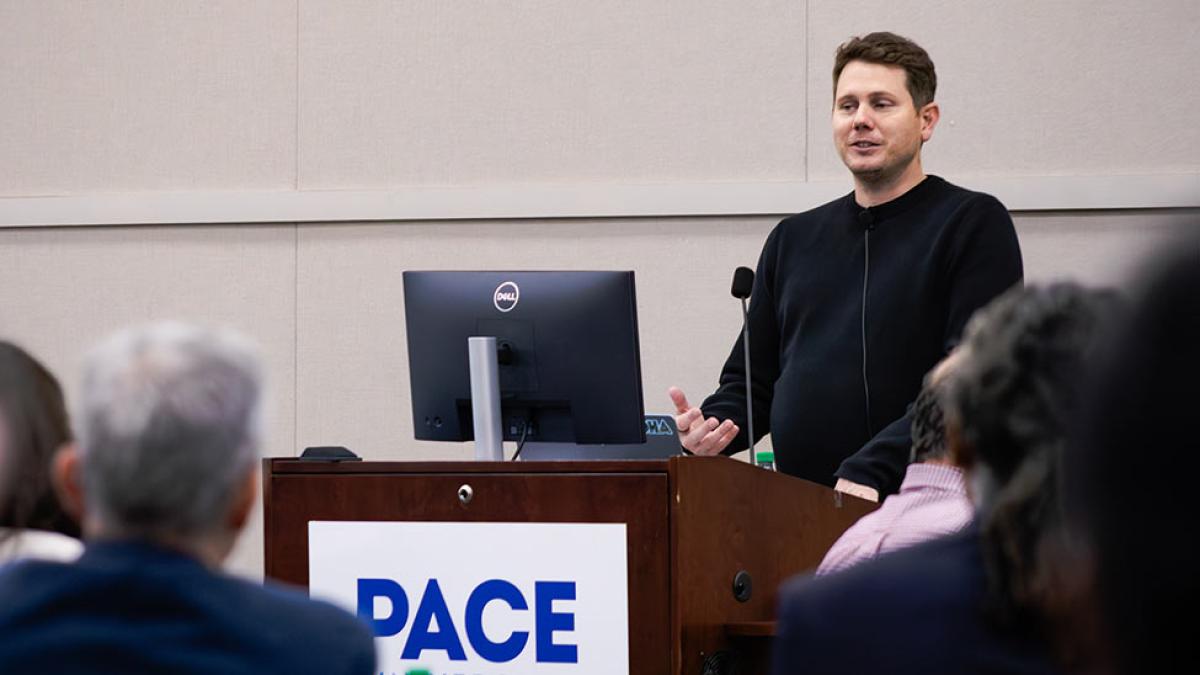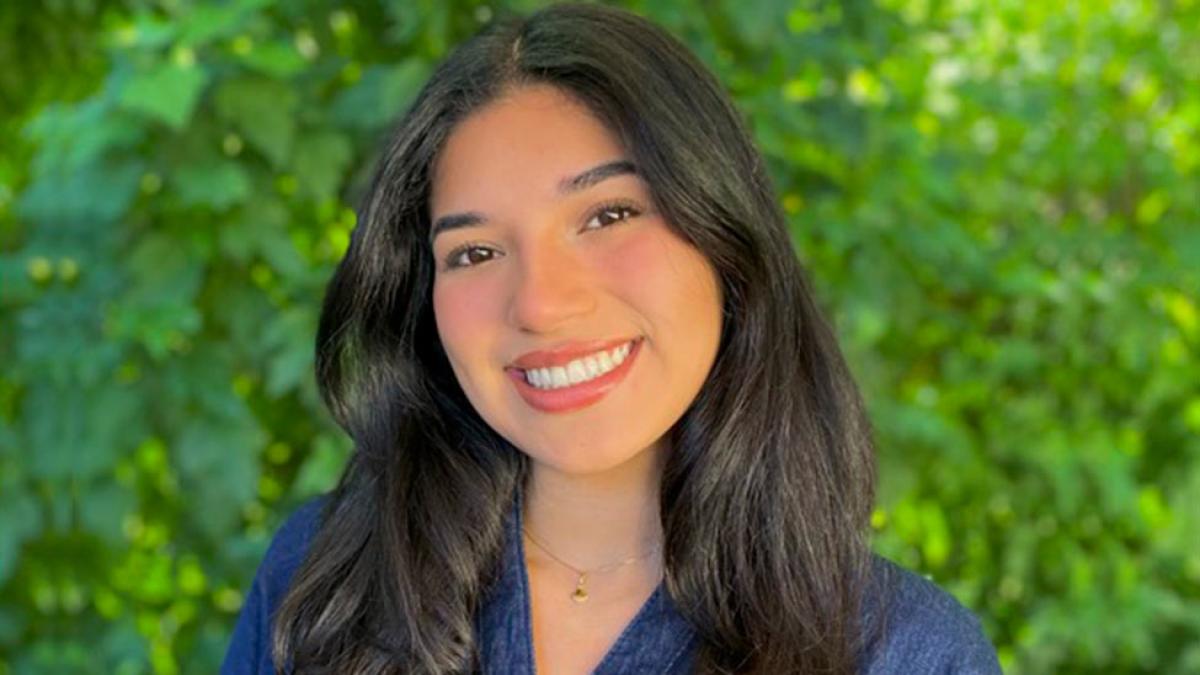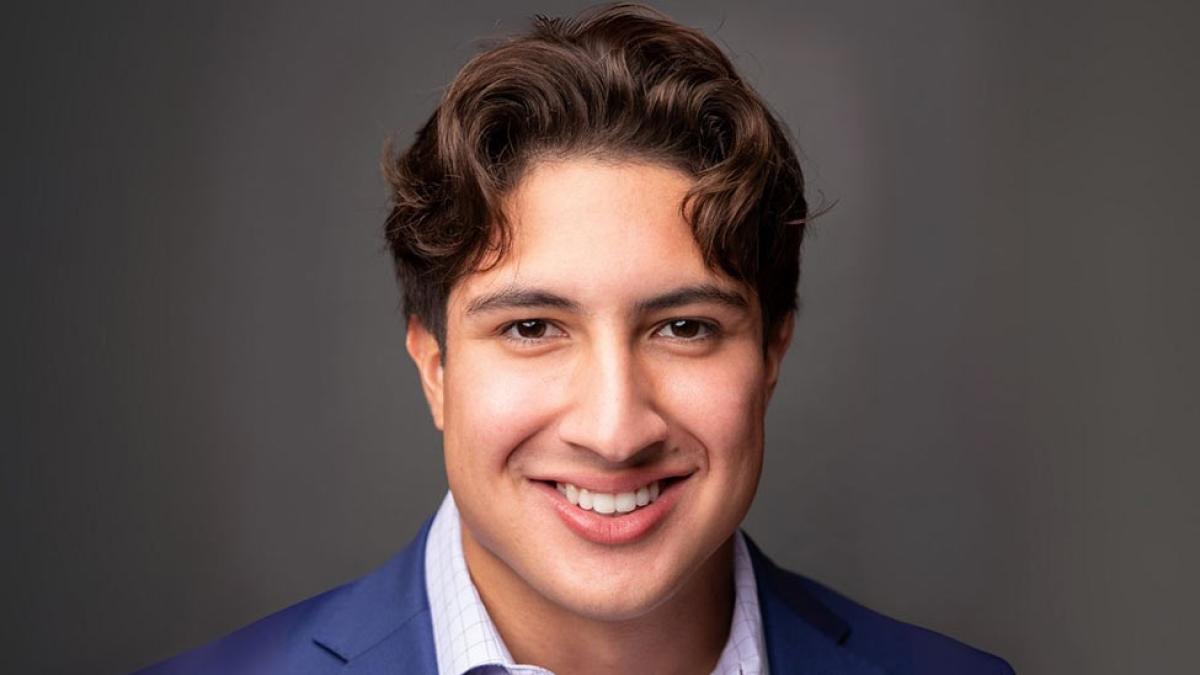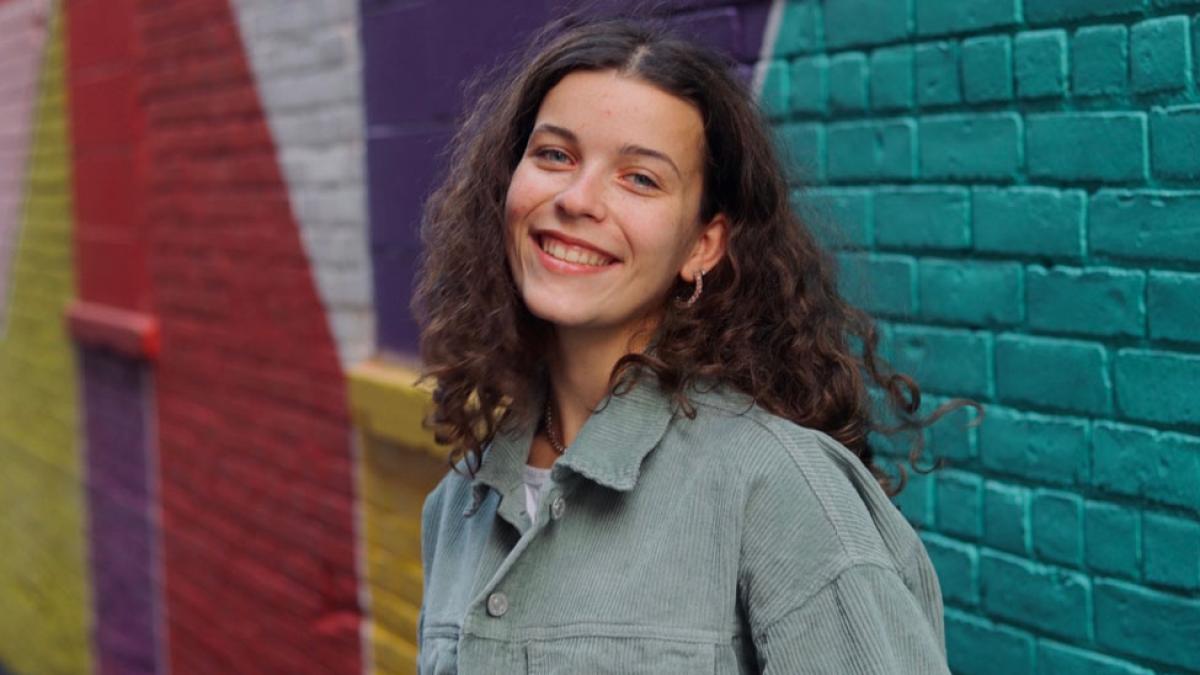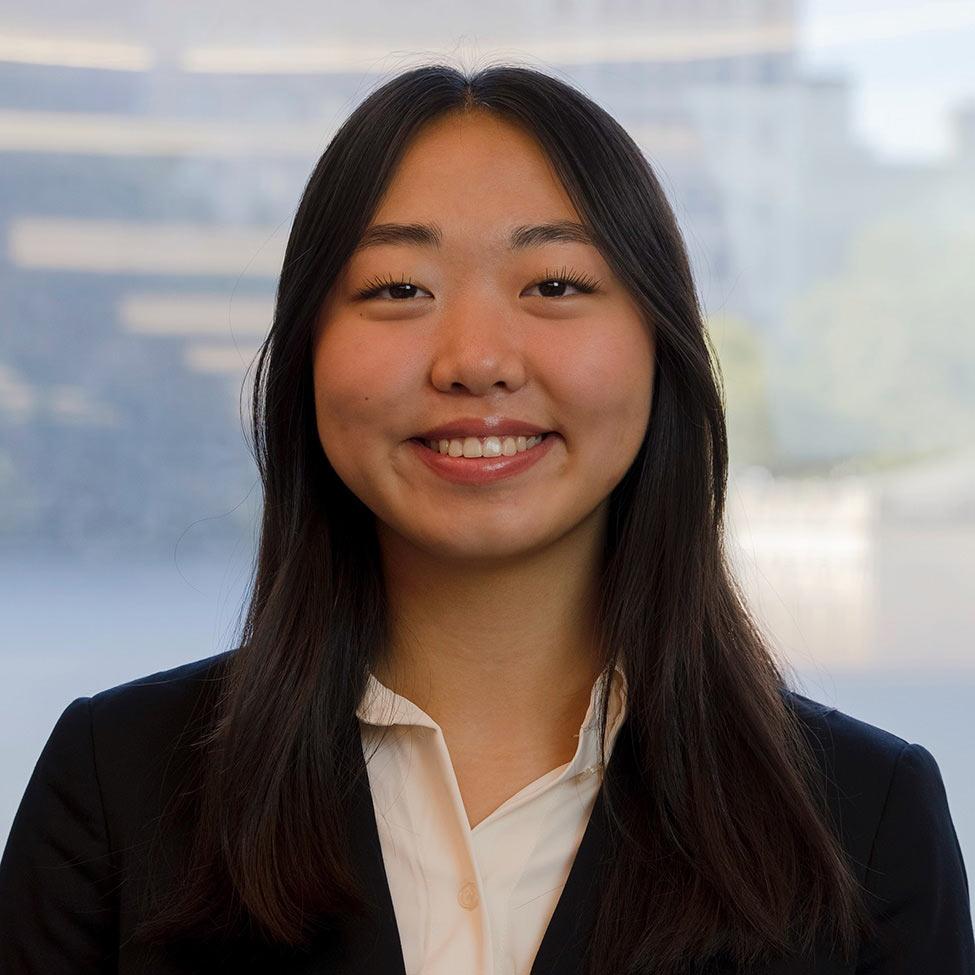
3 Unique Programs at Westchester Universities Prep Students for the Future
Westchester Magazine features Pace’s B.S. in Game Development program, highlighting how students transform their passion for gaming into successful career paths. With a curriculum spanning computer graphics, AI, and storytelling, the program positions students to thrive in one of the fastest-growing creative industries.
Pace University Partners with Westchester County to Address Hispanic Community Needs
- Read more about Pace University Partners with Westchester County to Address Hispanic Community Needs
News 12 Westchester reports on a groundbreaking Hispanic Community Needs Study conducted by Pace University – under the direction of Interim Associate Provost Rebecca Tekula and her MPA team – in collaboration with Westchester County Government. The study—first of its kind in over two decades—reveals key challenges facing Hispanic residents, from housing and healthcare access to workforce pathways divided by language, and recommends targeted policy responses like expanding affordable housing and bilingual health services— and Talk of the Sound has the story.
Preparing the Next Generation of Healthcare Workers
Pace University has been awarded more than $3 million from the New York State Department of Health’s Healthcare Education and Life-skills Program (HELP) to establish the College of Health Professions Pathways to Practice Initiative (CPPI.
Finding Community and Opportunity at Lubin
From Red Bull events to leading AMA, Anna Li is turning campus involvement into career-ready experience and discovering her passion for marketing along the way.
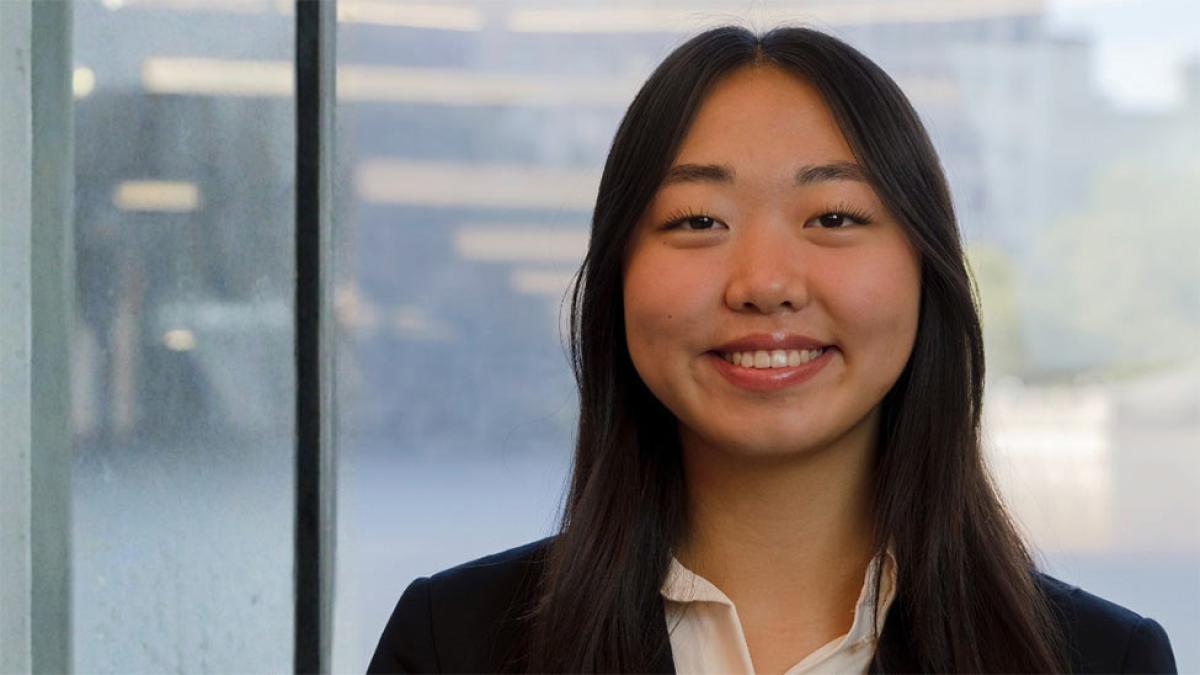
Anna Li
Class of 2027
Pronouns: She/Her
Currently Studying: BBA in Advertising and Integrated Marketing with a minor in Finance
Member (Clubs): Chief Financial Officer of the American Marketing Association (AMA), Student Marketeer for Red Bull at Pace University

Why did you choose Pace University and the Lubin School of Business?
I chose Pace University and the Lubin School of Business for the strong internship opportunities and professional connections it offers students. The wide variety of clubs also played a big role in my decision—they’ve had a life-changing impact on me.
How have clubs on campus helped enrich your student?
They’ve given me the chance to gain leadership experience early in my college career. Joining an E-Board as a second-year student helped me build a strong foundation, which eventually led to a core four E-Board role. I credit that growth to the teamwork and leadership opportunities I had early on.
What drew you to take on leadership roles in clubs like AMA, and how have those experiences shaped your time at Pace?
I was drawn to AMA because of the chance to collaborate on a team, help host events, and contribute behind the scenes. Getting to serve student needs in meaningful ways has been incredibly rewarding. These experiences helped me find my community and grow professionally.
I chose Pace University and the Lubin School of Business for the strong internship opportunities and professional connections it offers students.
What inspired your interest in your major, and how have you pursued that passion at Pace?
I was originally a finance major, but during my second semester of sophomore year, I attended the AMA International Collegiate Conference (ICC). Networking and connecting with students from around the world sparked my interest in marketing. After that, I met with my advisor and mapped out a path in Advertising and Integrated Marketing to align with my professional goals.
What has been your favorite opportunity at Pace?
Being a Student Marketer for Red Bull at Pace has been one of my favorite opportunities. It’s been an incredible experience that’s allowed me to plan events and collaborate with clubs across campus.
Do you have any advice for other Lubin students?
Get involved in clubs! Staying consistent and taking on leadership roles has transformed my professional growth. I wouldn’t have had half the experiences—or learned as much—without the amazing opportunities Pace’s clubs provide.
What does #LubinLife mean to you?
To me, #LubinLife means access to amazing professors, engaging classes, and professional development opportunities through Lubin’s many student clubs.
Connect with Anna
Press Release: Pace University Awarded Over $3 Million New York State Department of Health Grant to Strengthen Healthcare Workforce Pipeline in Region
Pace University has been awarded more than $3 million from the New York State Department of Health’s Healthcare Education and Life-skills Program (HELP) to establish the College of Health Professions Pathways to Practice Initiative (CPPI).
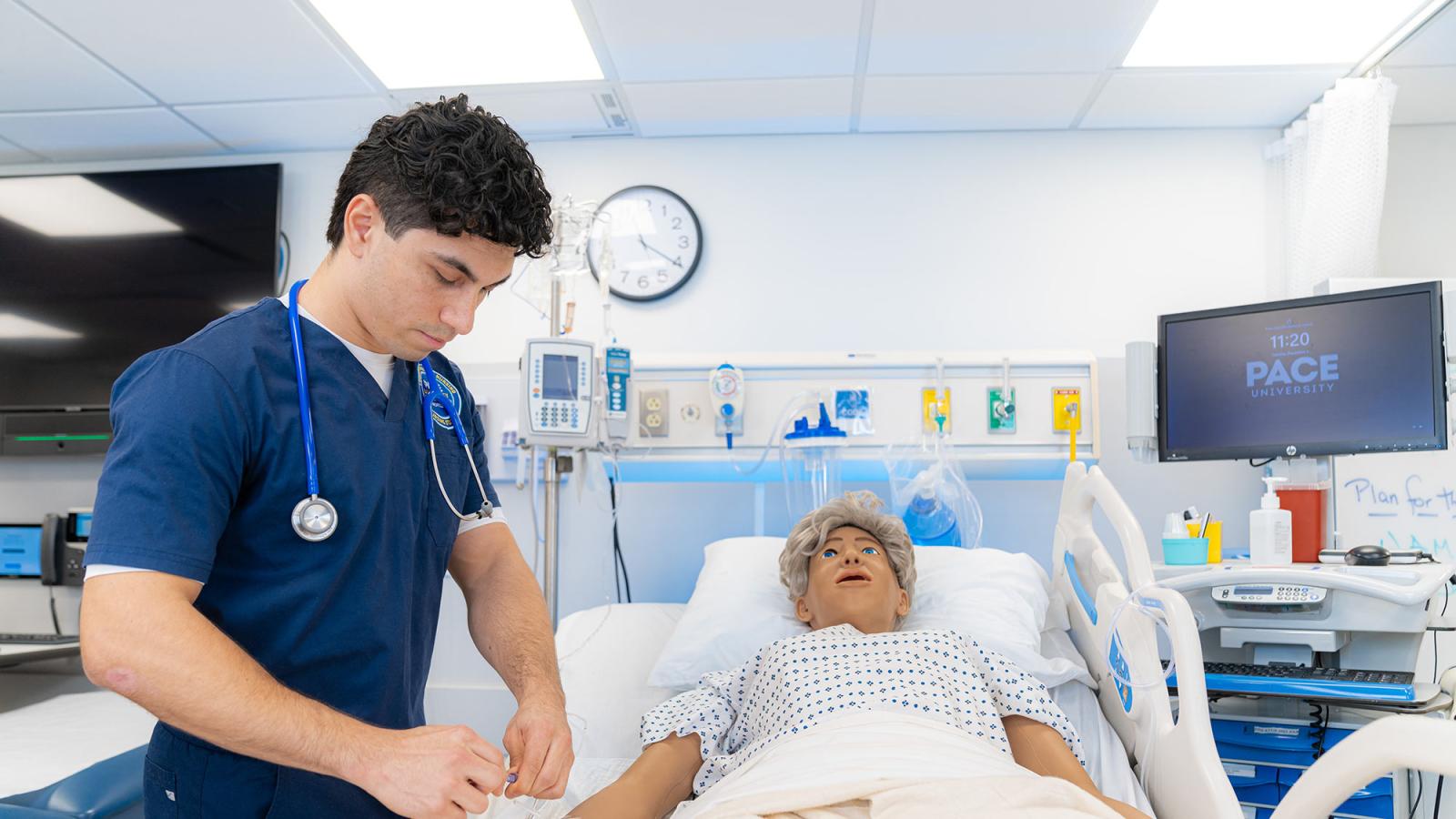
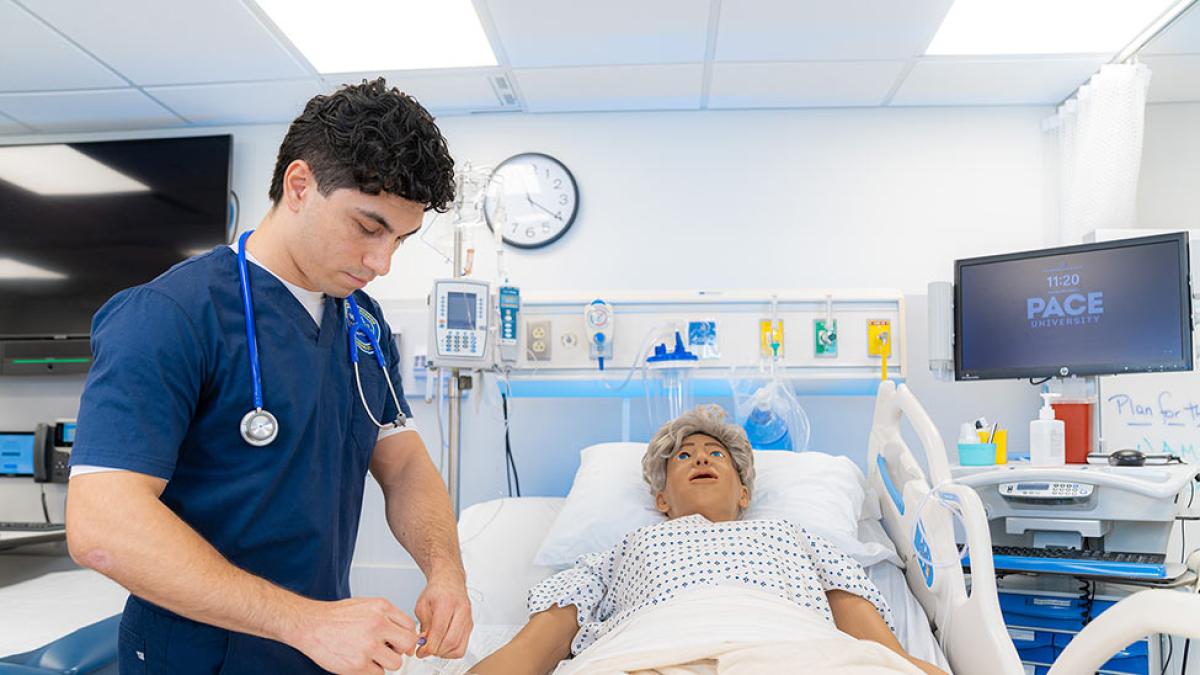
New initiative will expand access, strengthen pre-health advising, and prepare advanced healthcare students to address workforce shortages in the Lower and Mid-Hudson Valley
Pace University has been awarded more than $3 million from the New York State Department of Health’s Healthcare Education and Life-skills Program (HELP) to establish the College of Health Professions Pathways to Practice Initiative (CPPI).
The five-year award, providing $614,395 annually from January 2026 through December 2030, will support a comprehensive effort to strengthen the healthcare workforce pipeline across the Lower and Mid-Hudson Valley.
Led by Elizabeth Colón-Fitzgerald, EdD, associate dean of Student Success & Retention Strategies, the initiative was developed through a collaborative effort with faculty leaders Beau Anderson, Denise Tahara, Esma Paljevic, and Shannon Gribben. The project also benefited from the expertise of Memorial Sloan Kettering Cancer Center (MSK) collaborators Dr. Margaret Barton-Burke and Dr. Annmarie Mazzella-Ebstein. Together, the team designed CPPI to expand access for underrepresented students, bolster advising for pre-health majors, and prepare advanced nursing and health sciences students to transition successfully into high-demand clinical roles.
“This grant is an extraordinary opportunity for Pace’s College of Health Professions to strengthen the healthcare workforce in Westchester,” said Brian Goldstein, dean of the College of Health Professions at Pace University. “Through the Pathways to Practice Initiative, we will expand access to healthcare education, support students as they prepare for advanced roles, and ensure that our graduates are ready to meet the evolving needs of patients and communities across the Lower and Mid-Hudson Valley.”
The initiative features three interconnected programs:
- CHP Scholars Program (CHP-SP): Expands access to healthcare education by supporting Black and Latino students in nursing and health sciences through financial aid, mentorship, and academic coaching.
- Pre-Health Advising Program (PHAP): Strengthens the pipeline for critical healthcare roles by providing tailored advising, career exploration, and graduate school preparation for pre-health students University-wide.
- Student-to-Practice Program (SPP): Equips final-semester NP, PA, and RN students with the tools to manage stress, enhance wellness, and build resilience through workshops and simulations facilitated by MSK and Pace faculty.
“This award not only affirms Pace University’s leadership in healthcare education, but it also represents a collaborative effort to build a stronger, more resilient healthcare workforce,” said Elizabeth Colón-Fitzgerald, EdD, associate dean of Student Success & Retention Strategies and principal investigator for the grant. “Through the Pathways to Practice Initiative, we are expanding access, strengthening support for students, and preparing graduates to thrive in the most demanding clinical environments.”
“Building on the Academic-Clinical Partnership between Memorial Sloan Kettering Cancer Center and the Lienhard School of Nursing at Pace University gives us traction to prepare nurses of the future with grants like HELP,” said Margaret Barton-Burke, Ph.D., RN, FAAN, and Lisa Mazzella Ebstein, Ph.D., RN, of Nursing Research at MSK. “We will contribute by implementing resilience and emotional intelligence training. Offering this training before workforce entry can foster emotional wellness, enhance coping strategies, and mitigate burnout. Thus, supporting the well-being and efficacy of nurses. We are excited to collaborate on this important initiative over the next five years.”
This award also expands Pace University’s partnership with MSK, a global leader in clinical care, research, and training. Together, Pace and MSK are creating a model for preparing the next generation of healthcare professionals to meet the evolving needs of patients and communities across the Lower and Mid-Hudson Valley.
About Pace University
Since 1906, Pace University has been transforming the lives of its diverse students—academically, professionally, and socioeconomically. With campuses in New York City and Westchester County, New York, Pace offers bachelor, master, and doctoral degree programs to 13,600 students in its College of Health Professions, Dyson College of Arts and Sciences, Elisabeth Haub School of Law, Lubin School of Business, School of Education, and Seidenberg School of Computer Science and Information Systems.
About the College of Health Professions at Pace University
Established in 2010, the College of Health Professions (CHP) at Pace University offers a broad range of programs at the bachelor, master's, and doctoral levels. It is the College's goal to create innovative and complex programs that reflect the changing landscape of the health care system. These programs are designed to prepare graduates for impactful careers in health care practice, health-related research, or as educators, and equip graduates to work in health policy and global health fields. Students in clinical programs receive hands-on training in the College's interprofessional Center of Excellence in Healthcare Simulation and have the opportunity to apply their developing skills in real-world settings at many of the regions' leading clinical facilities. In addition to Nutrition and Dietetics, the College currently comprises several growing and important areas of study, which include nursing, physician assistant, communication sciences and disorders, health science, nutrition and dietetics, occupational therapy, health informatics, and public health.
Building Better Leaders Through the Science of Happiness
Driven by her own story of resilience, Ipshita Ray, PhD, is leading Lubin’s new Center for Leadership and Emotional Intelligence in collaboration with Harvard’s Leadership and Happiness Laboratory. Learn how this new program is helping equip the next generation of leaders through the science of happiness.
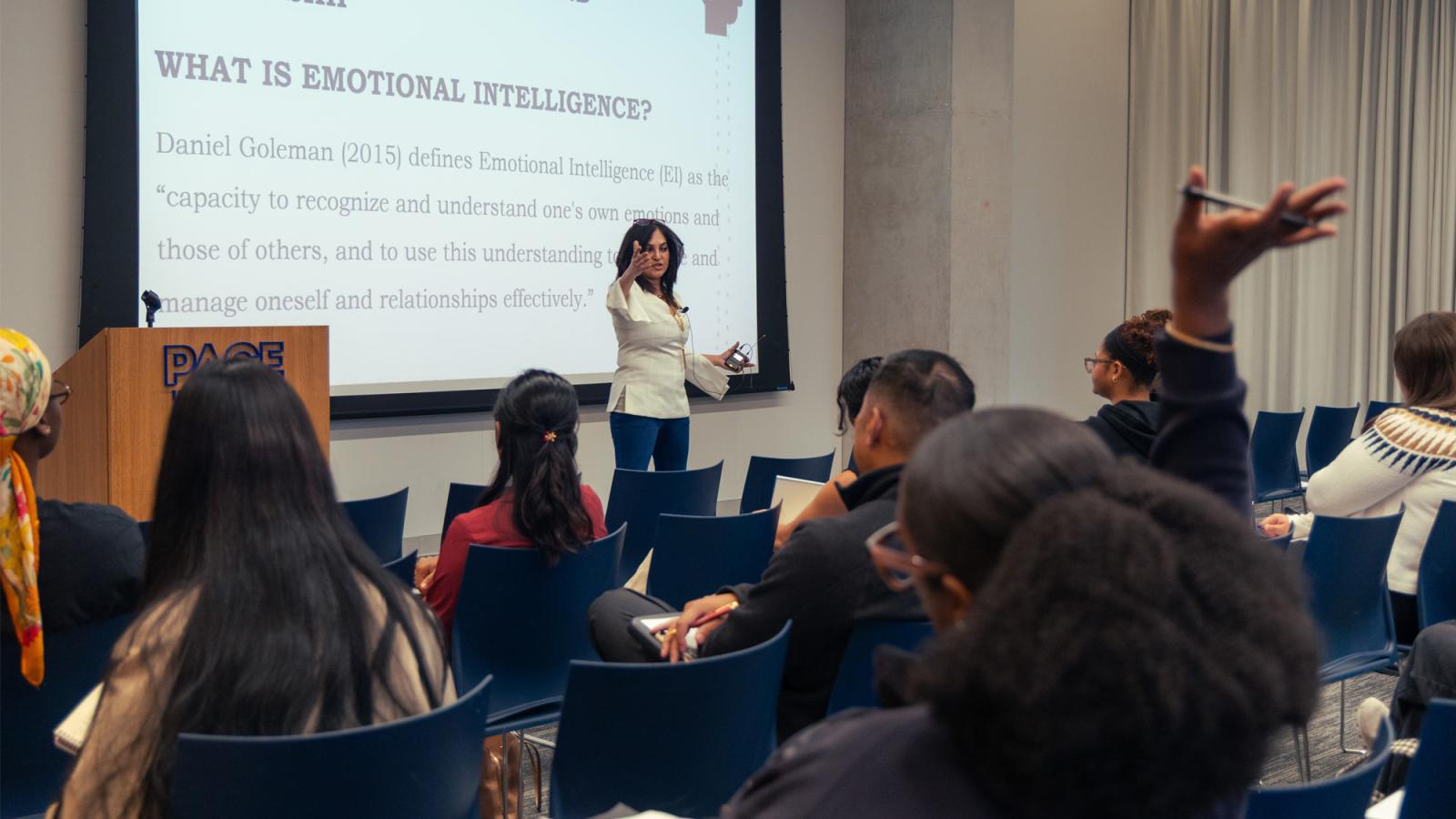
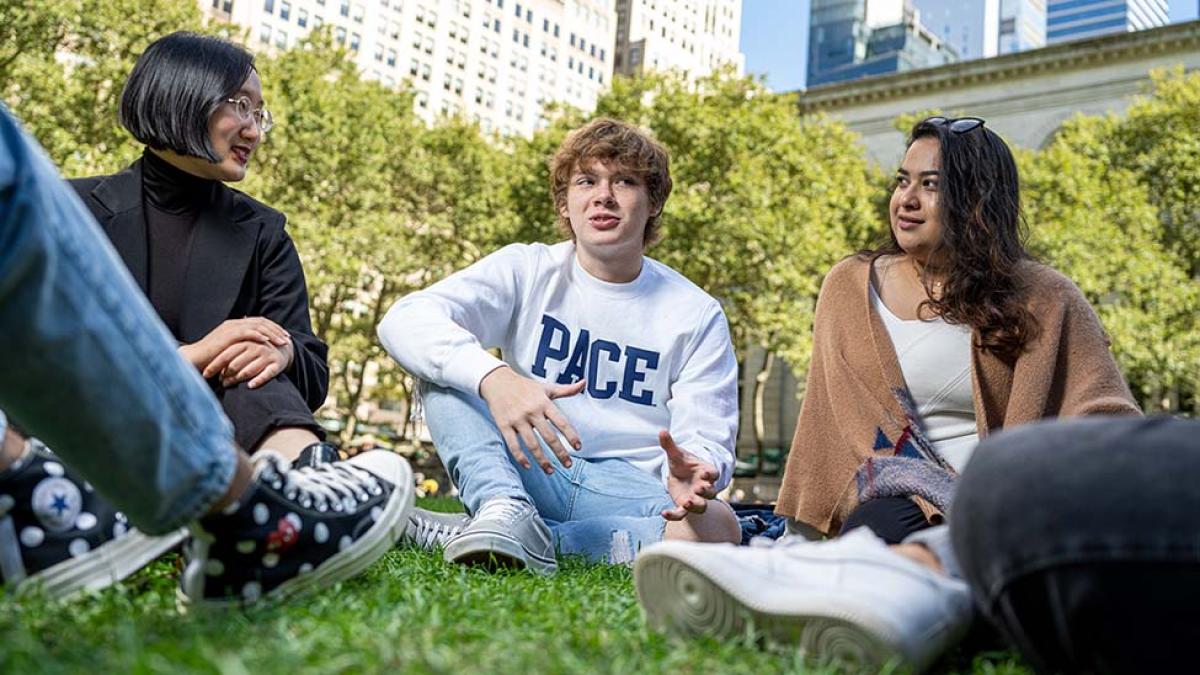
The Lubin School of Business is launching a bold new initiative this fall aimed at reshaping how students understand success—and themselves.
The Center for Leadership and Emotional Intelligence, housed within the Lubin School of Business was created in partnership with Harvard professor and Kennedy school professor Arthur Brooks, who also runs the Leadership and Happiness Laboratory. The Center introduces a free six-session, non-credit program designed to teach Pace University students the science behind happiness and how it intersects with transformative leadership.
Ipshita Ray, PhD, a graduate program chair in Lubin, is the driving force behind the center. Her vision, born from a personal journey of resilience and renewal, has transformed into a mission to empower students with tools that go beyond theory.
From Adversity to Action
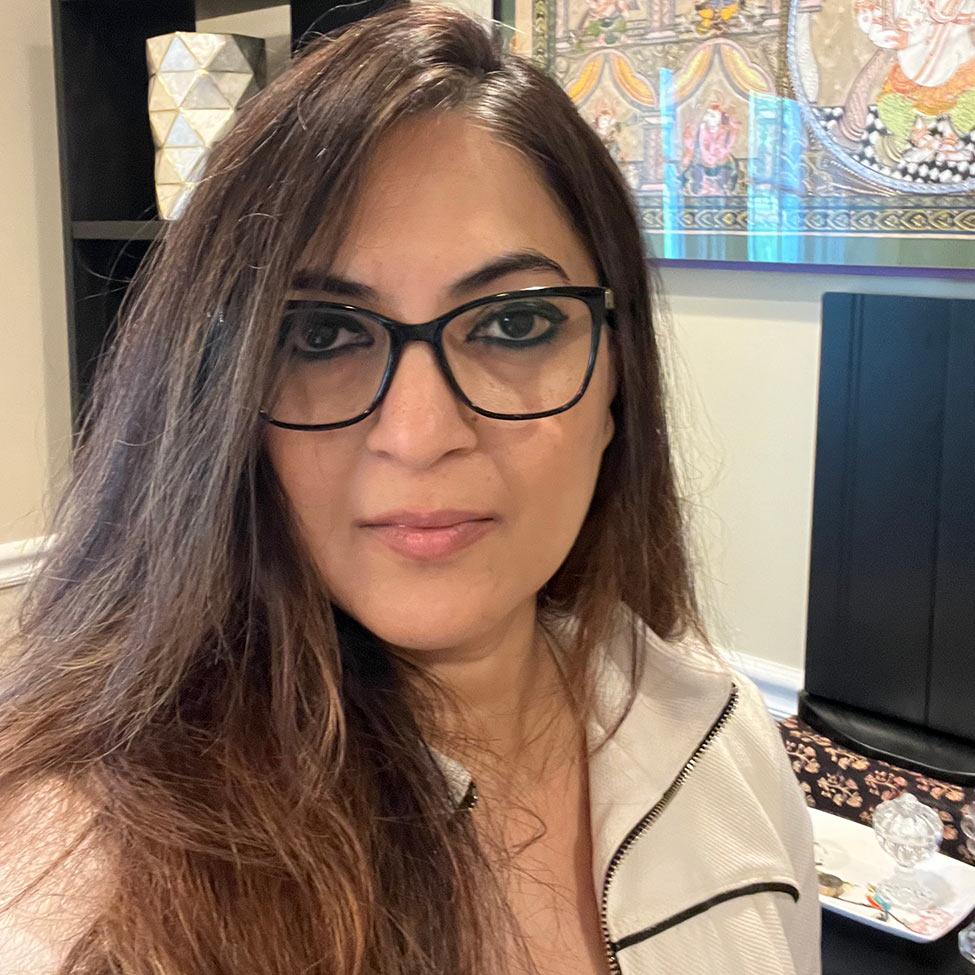
Ray’s vision for the center emerged during one of the most difficult chapters of her life: a battle with stage three cancer.
“I’ve been blessed with a second chance, and my mission is not to waste it, but to do something meaningful,” she explains. “I truly believe that my Pace Community, my colleagues and friends, saved my life.”
Her return to teaching, especially during COVID-19, was met with a profound awareness of how deeply her students were struggling to navigate the world and find purpose. “I realized the students were hurting inside,” Ray says. “I didn’t want to just teach them material for academic purposes. I wanted to do something with impact.”
That “something” became a letter to Arthur Brooks, PhD, at Harvard Kennedy School. She read his book From Strength to Strength during her battle with cancer and was moved by his work at Harvard Kennedy School’s Leadership and Happiness Laboratory.
Ray reached out to Brooks and shared her story—and a proposal. She wanted to bring his work and her story to Pace.
Purposeful Partnerships
Brooks, renowned for his bestselling book Build the Life You Want (co-written with Oprah Winfrey), has long advocated for embedding the science of happiness into leadership education. His lab at Harvard creates research and training for leaders across government, business, and academia.
Ray worked in conjunction with Brooks to develop a curriculum based on his work and her own experiences here at Pace. “The lessons are designed around how happiness can be a daily practice—how you can take it from a feeling to a state of being,” Ray explains. “It’s about converting negative energy into positive energy.”
It’s about building leaders with a foundational happiness that allows them to elevate the people that surround them.
Each of the six in-person sessions focuses on a different facet of emotional intelligence and practical leadership. “This program is about building leaders who lift others up,” Ray explains. “Leaders whose main purpose is service, not wealth or power. It’s about building leaders with a foundational happiness that allows them to elevate the people that surround them.”
The center is backed by Lubin Dean Emeritus and former NBCUniversal president Neil Braun, who has pledged funding support and will co-teach the course alongside Ray, tying Ray’s curriculum into real-world leadership skills. Upon completion, students will receive a certificate indicating they’ve taken part in a curriculum designed by Harvard Kennedy School faculty in collaboration with Lubin and take part in a networking event featuring C-suite leaders and recent Pace alumni.
High Hopes for Spreading Happiness
Though the initiative launches within Lubin this fall, Ray already has high hopes for the future of the center. She hopes to expand the offering across Pace, to help bring the curriculum to other New York schools, and even establish a formal dual-degree program with Harvard.
“I want to make this a major movement,” she says. “My hope is to expand the program University-wide, which would allow Harvard to list us on their website, invite us to symposia, and co-lead research.”
I want to make this a major movement.
Her goal for the present, however, is to help the students of Pace right now.
“How can you lead if you don’t see the value in yourself or others?” Ray asks. Her hope in bringing the science of happiness to Pace students is to empower them to not only learn and lead better, but to live better.
In an era where young people feel more alone and purposeless than ever, Ray believes programs like this are not just helpful, they’re necessary. “I want students to understand they have complete agency over their choices,” Ray says. “I believe a winning life is a choice, that happiness is a choice.”
The Center for Leadership and Emotional Intelligence is open to all Lubin students. Learn more about the Center and how you can get involved.
More from Pace
At 25, Soumyadip Chatterjee ’23 began his Pace journey. By 27, he was the youngest senior software engineer on a major project at Wells Fargo. Read his story to see how he turned challenges into motivation to go further.
Your Commencement isn’t just about walking the stage—it’s about celebrating the people and values that got you here. That’s why we want the Class of 2026 to help choose our Commencement speaker and the recipient of the Opportunitas in Action Award. Think of someone whose story will light up the room, inspire your classmates, and leave a lasting mark. Ready? Nominate now.
The Pace Energy and Climate Center (“PECC") is thrilled to announce the 2025–2026 Executive Board, which is comprised of three exceptional Elisabeth Haub School of Law at Pace University students committed to advancing PECC’s mission and outreach.
Record-Breaking Year: 34 Pace Students Named Millennium Fellows
More Pace students than ever—34 across both campuses—have been named UN Millennium Fellows, tackling the world’s biggest challenges through local action and global collaboration. From clean water to climate change, these Go-Getters are making their mark.

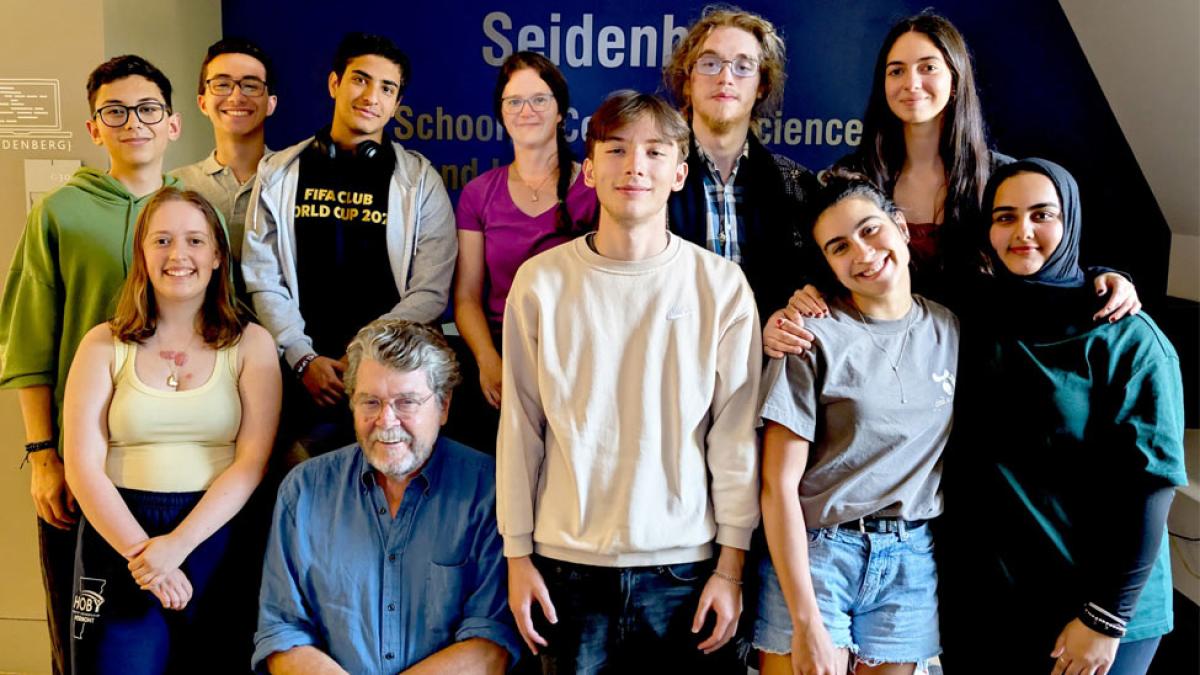
Pace University is proud to announce that a record-breaking 34 students have been selected as United Nations Academic Impact–MCN Millennium Fellows for the Class of 2025. This milestone reflects not only the strength of our student leaders, but also Pace’s growing global presence and commitment to social impact.
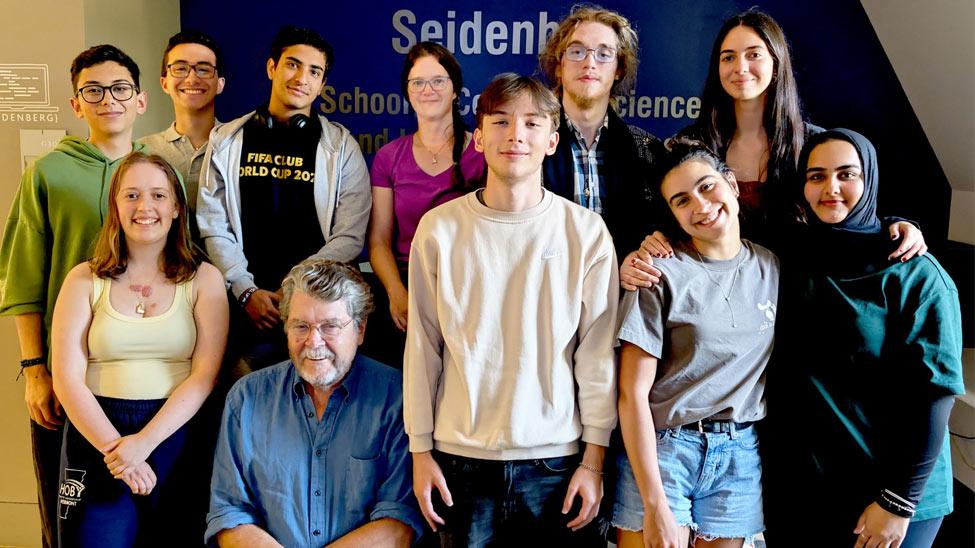
The Millennium Fellowship is a prestigious, semester-long leadership development program that empowers undergraduates to advance the United Nations Sustainable Development Goals (SDGs) through campus- and community-based projects. This year, more than 60,000 students from over 7,500 campuses around the world applied—and only 4 percent were accepted.
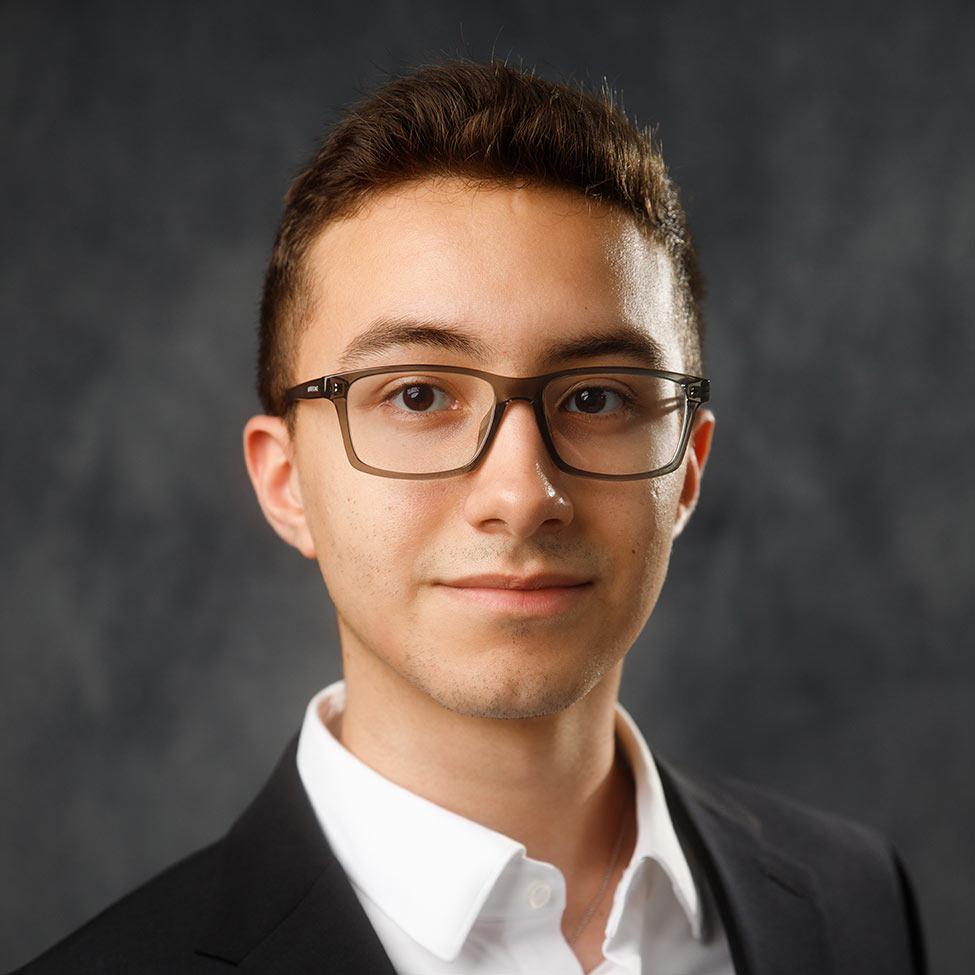
Pace’s 2025 Fellows represent the most inclusive and interdisciplinary cohort in our history, with students from Dyson College of Arts and Sciences, the Lubin School of Business, the School of Education, the Seidenberg School of Computer Science and Information Systems, and the College of Health Professions all taking part. Their projects span a wide range of pressing issues including healthcare, sustainability, equity, education, housing insecurity, and environmental justice, underscoring Pace’s continued leadership in experiential learning.
For many Fellows, the opportunity is both humbling and motivating. “I truly could not be more honored to be one of Pace’s Campus Directors for the Millennium Fellowship,” said Silas B. Gonzalez ’28. “Not only have I been able to work with Pace students to further the UN Sustainable Development Goals, but I have also been fortunate to meet change leaders from around the world! It truly is a blessing to be able to materialize and progress the change you want to see in the world.”
This year also marks a groundbreaking first: an international Millennium Fellowship team formed through a partnership between the Seidenberg School and Finland’s Häme University of Applied Sciences. This 19-member team is working on a bilateral framework for a global “right-to-know” standard regarding water quality—a vital aspect of SDG 6 (Clean Water and Sanitation). The team will present their findings at the United Nations in October, when the Finnish students travel to New York to join their Pace counterparts in person. This collaboration stands as a powerful example of student-driven innovation with global significance.
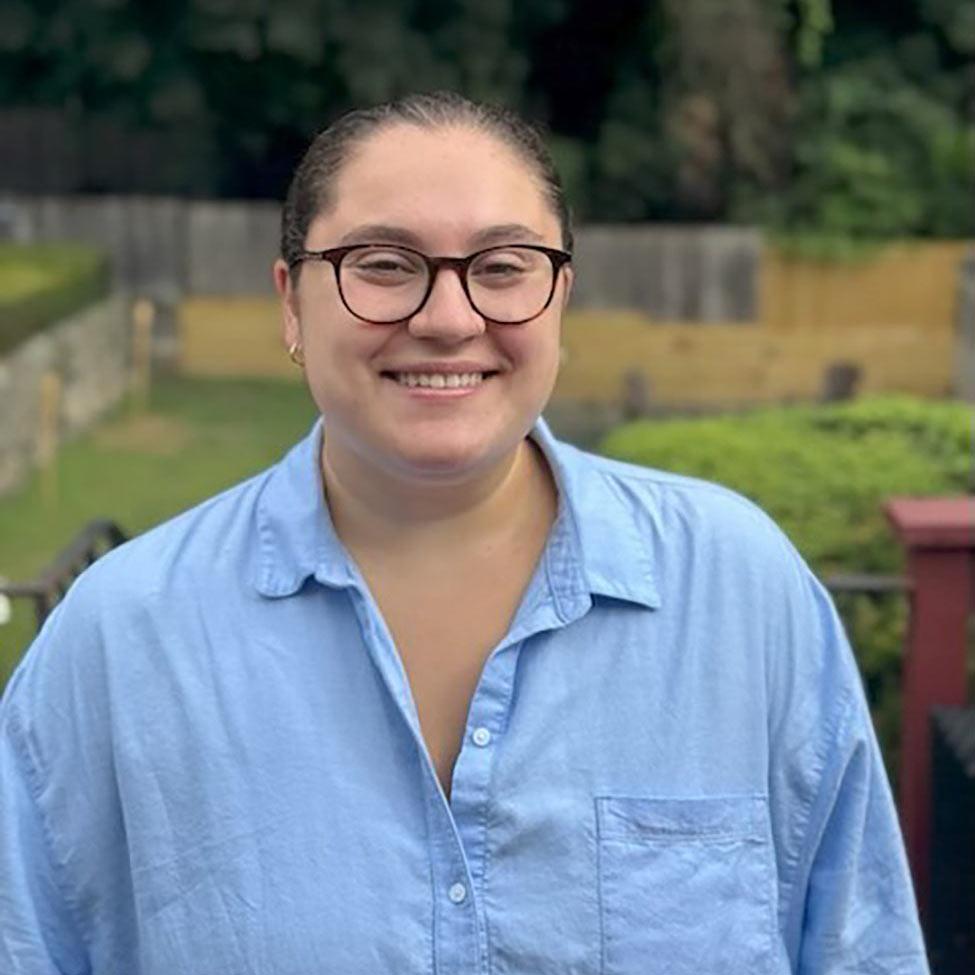
For others, the fellowship has opened doors to pursue passions and connect with peers worldwide. “It’s an honor to be a part of this fellowship!” said Samantha Sergi ’28. “I’ve had the opportunity to meet the board and other fellows across the world during the town hall meeting. I’ve also had the opportunity to continue my passion into spreading awareness about human trafficking. It’s exciting that Pace is having their largest cohort ever and I’m looking forward to meetings with members from this community!”
Even early in the program, Fellows are finding the work deeply meaningful. “This experience so far has felt really rewarding,” said Rachel Parker ’25. “Even though it is still early on, it feels great involving myself in the community and trying to make a positive impact, even if it’s in a small way.”
Together, Pace’s Millennium Fellows are not just learning—they’re leading. Their projects, collaborations, and voices reflect the University’s mission to prepare students to take on the world’s greatest challenges with courage, creativity, and conviction.
For more information about the UN Millennium Fellow program, contact Sue Maxam, PhD, at smaxam@pace.edu.
More from Pace
In speaking at Pace University’s inaugural Actionable AI Conference in Pleasantville on Friday, Charles Elliot, head of industry at Google Cloud, advised attendees that when using AI tools, they should lean into learning, focus on the end-user, and be curious about the application of evolving technologies.
Reconnect with your student and experience the best of Pace this October—from campus events and athletics to Broadway shows and local adventures in Westchester and New York City.
From City Hall to Albany, your vote shapes New York’s future. Local and state elections are happening just around the corner. From registering to vote, casting your ballot on campus, to attending fun voter engagement events, Pace University has you covered. Check out our guide to all things voting, powered by the Center for Community Action and Research and the Andrew Goodman Foundation.
October 2025: A Message from President Krislov
In his monthly message, President Marvin Krislov highlights the energy driving Pace forward this fall—from Homecoming and civic engagement to record-breaking student achievements and the first steps toward Commencement 2025.
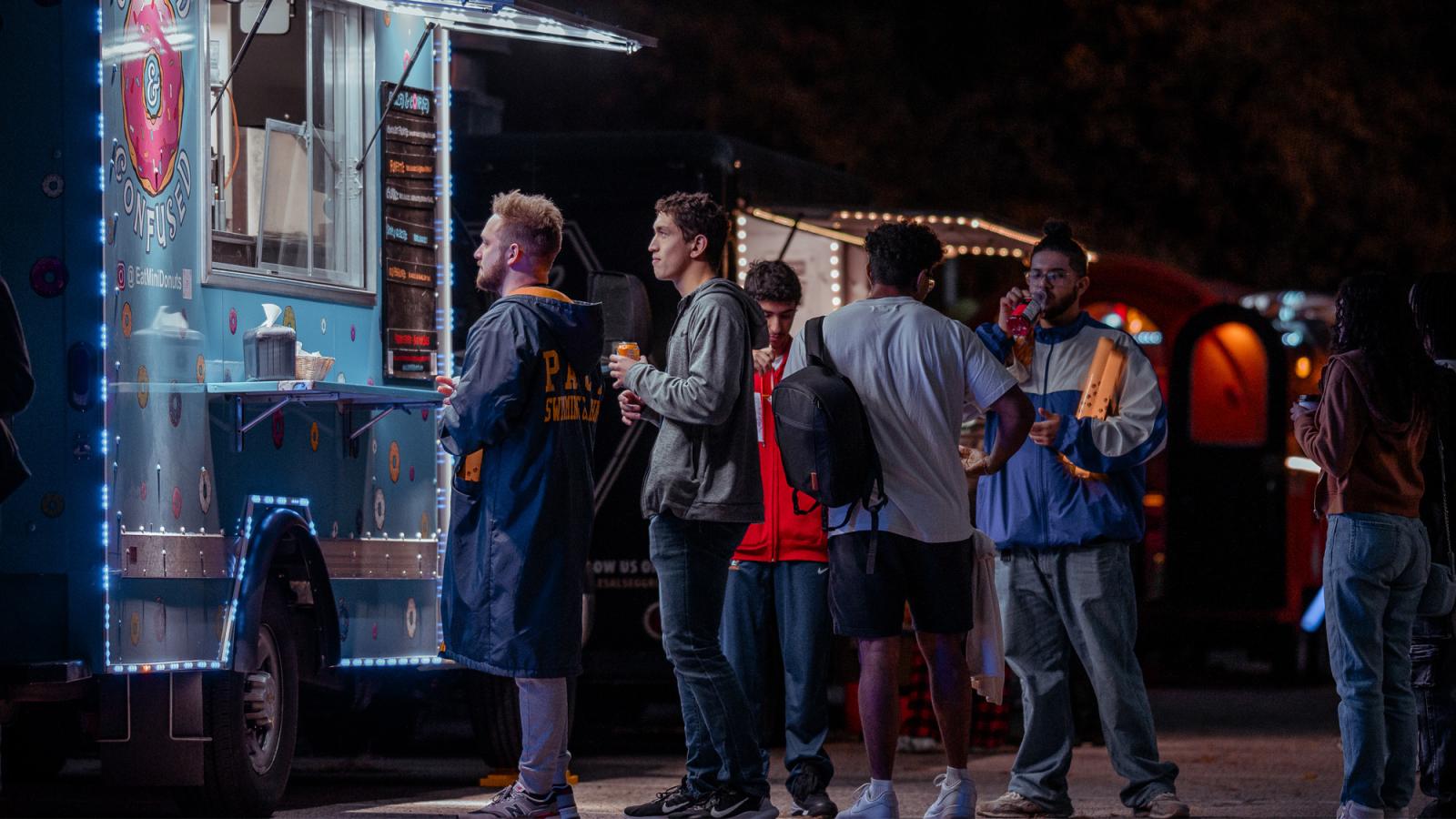
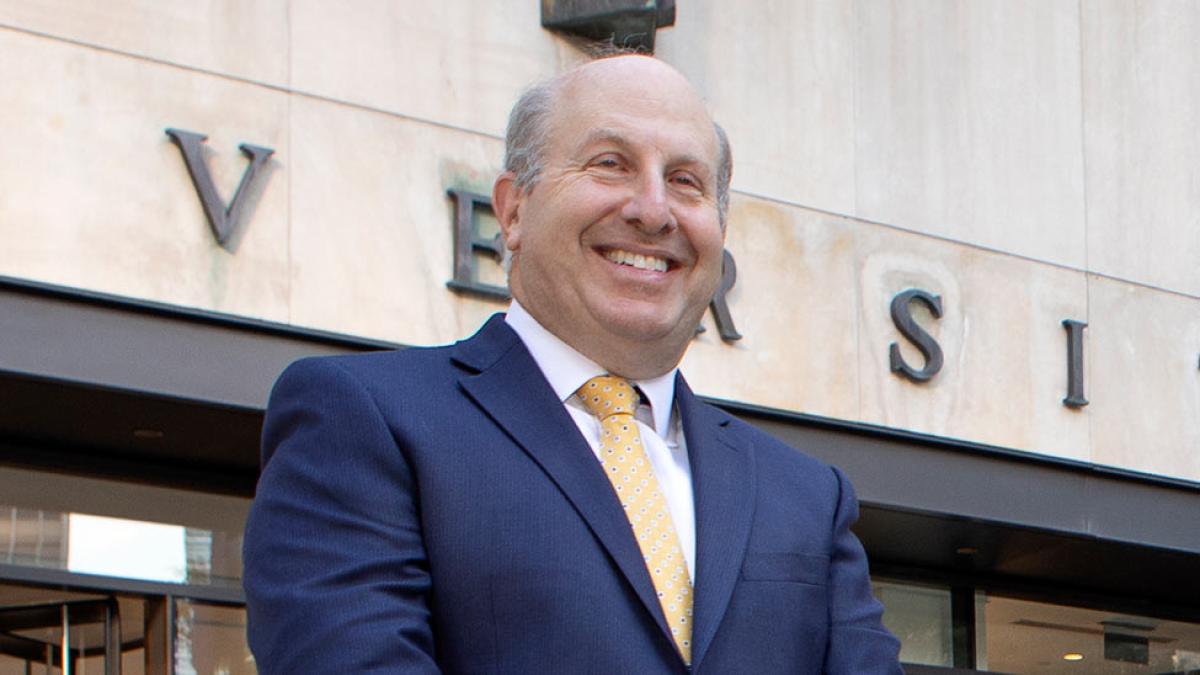
Every semester brings new opportunities to move forward.
At Pace, we don’t wait to get started. Already this fall, I’m seeing that drive in action: in our classrooms, labs, student initiatives, and community programs.
We roll up our sleeves. We get to work. And we create opportunities through research, creative exploration, civic engagement, and a deep commitment to our students and one another.
This is also a good time to reconnect. For Staff and Faculty, I hope you'll join us at one of the upcoming Community Conversations, where we’ll gather in person to reflect, listen, and keep moving forward together. We will also welcome alumni, families, and friends back to our campuses for Homecoming, a moment to celebrate our shared pride in Pace and the strength of our community.
Our commitment to civic engagement is also stronger than ever. With Pace Votes 2025, we’re making sure every member of our community has the tools and support they need to participate—from registering to vote, to casting your ballot on campus, to joining voter engagement events.
I am also proud to share that 34 Pace students have been named UN Millennium Fellows, the largest number in our history. These exceptional students are addressing global challenges through local action and embodying the Pace mission to make a difference.
Looking ahead, planning is already underway for Commencement 2025. Nominations are now open for Commencement speakers and for the Opportunitas in Action Award. These honors reflect the values of our University and celebrate those who inspire and elevate our community. I encourage you to consider leaders, changemakers, and community builders whose voices will guide and motivate the Class of 2026, and to submit your nominations.
Thank you, as always, for being part of this remarkable community. I look forward to seeing what we do next.
Warmly,
Marvin Krislov
President
More from Pace
Your Commencement isn’t just about walking the stage—it’s about celebrating the people and values that got you here. That’s why we want the Class of 2026 to help choose our Commencement speaker and the recipient of the Opportunitas in Action Award. Think of someone whose story will light up the room, inspire your classmates, and leave a lasting mark. Ready? Nominate now.
More Pace students than ever—34 across both campuses—have been named UN Millennium Fellows, tackling the world’s biggest challenges through local action and global collaboration. From clean water to climate change, these Go-Getters are making their mark.
Reconnect with your student and experience the best of Pace this October—from campus events and athletics to Broadway shows and local adventures in Westchester and New York City.
Coding My Way From India to Wall Street
At 25, Soumyadip Chatterjee ’23 began his Pace journey. By 27, he was the youngest senior software engineer on a major project at Wells Fargo. Read his story to see how he turned challenges into motivation to go further.
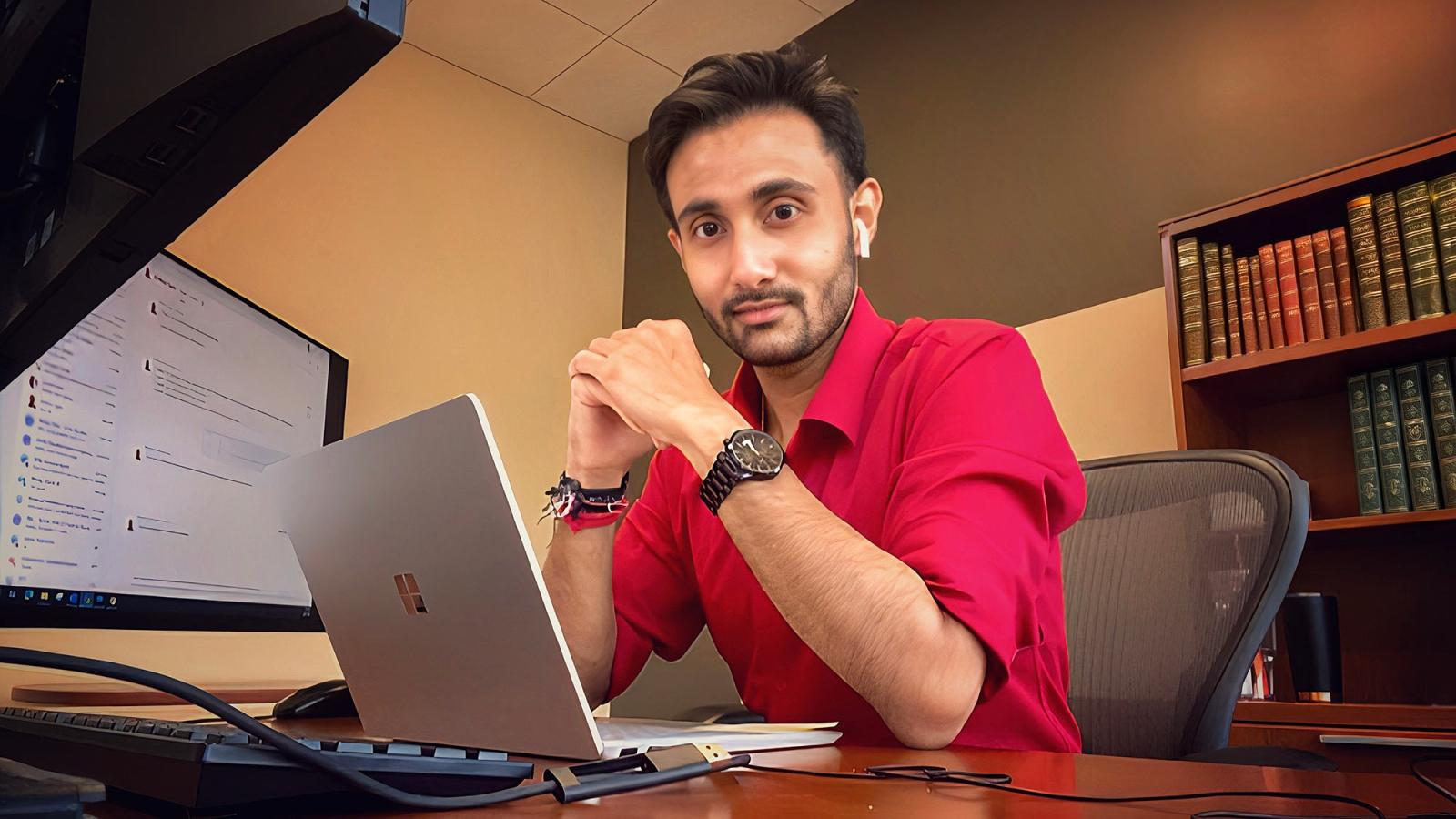
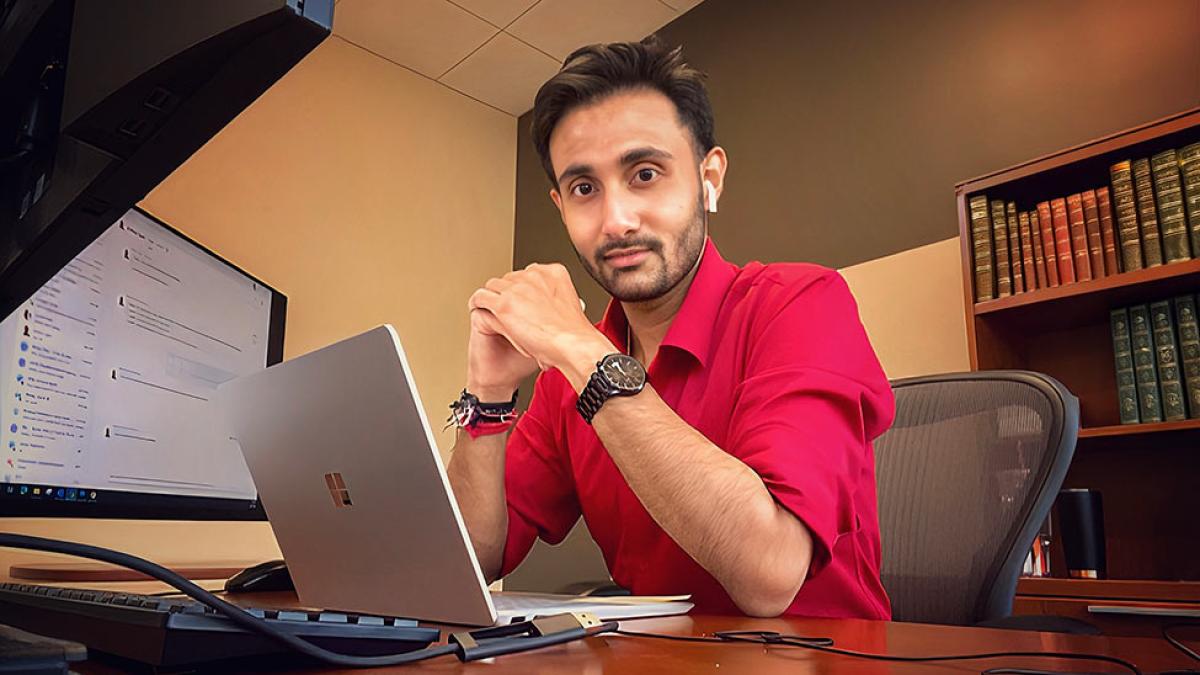
I was born and raised in Kolkata, India—a city that shaped my curiosity, drive, and ambition. From an early age, I dreamed of studying computer science in the heart of New York City. That dream came true when I was accepted into Pace University’s MS in Computer Science program, supported by a merit-based scholarship that recognized both my industry experience as a software engineer and my portfolio of national and international research publications.
At 25, I began my journey at Pace, stepping into a fast-paced and ambitious academic environment on Pace’s New York City Campus. There, I was taught by some of the finest professors in the country.
But the journey was far from easy.
At one point, I wanted to drop out. I faced immense adversity, including a months-long hospitalization. Yet I refused to give up. Drawing strength from within and encouragement from faculty, I pushed forward. One of my professors told me, “You’re already in the top 20 percent. Now step out of your comfort zone and get into the top 5 percent.” That line stayed with me.
Against the odds, I graduated early, completing my degree in May 2023.
I credit my success to thorough preparation, guidance from multiple professors, and support from Pace’s Career Services.
Immediately after graduating, I began an internship at a multimillion-dollar tech firm. But I was hungry for more. In 2024, I secured a senior software engineer role at Wells Fargo—one of the largest and most prestigious financial institutions in the United States, consistently ranked among the top banking firms by Forbes. The company serves one in three U.S. households and more than 10 percent of small businesses, with operations spanning banking, investment, and technology.
At just 27, I became the youngest senior software engineer on a major federal project within Wells Fargo. During my interview, I was told I stood out among 12 other experienced candidates. They were surprised by the depth of my answers, especially given my age. I credit my success to thorough preparation, guidance from multiple professors, and support from Pace’s Career Services.
Fear ends where learning begins.
Beyond academics and career milestones, I also stepped up as a leader. Today, I lead cross-functional teams that include professionals from different nationalities and age groups. Thanks to Pace’s International Buddy Program and its diverse community, I learned how to connect with people from all walks of life. That experience has helped me tremendously in the workplace.
I hope my story inspires aspiring engineers to take the leap. I’ve never been scared of failure, because I’ve always believed: Fear ends where learning begins.
More from Pace
Melanie Prado ’26 is making her mark at Warner Bros. Discovery—building connections, driving inclusive storytelling, planning high-impact events, and gaining real-world experience in the fast-paced world of entertainment.
From deal analysis to networking, Christian Valerio ’27 dives into private equity at Court Square, shaping his path in finance.
Meet Lubin student Leah Gaffney '22, a sales star whose leadership roles with the Brand Marketing Team, Sales Team, and American Marketing Association helped jumpstart her career.
Pace Energy and Climate Center Announces 2025–26 Executive Board
The Pace Energy and Climate Center (“PECC") is thrilled to announce the 2025–2026 Executive Board, which is comprised of three exceptional Elisabeth Haub School of Law at Pace University students committed to advancing PECC’s mission and outreach.
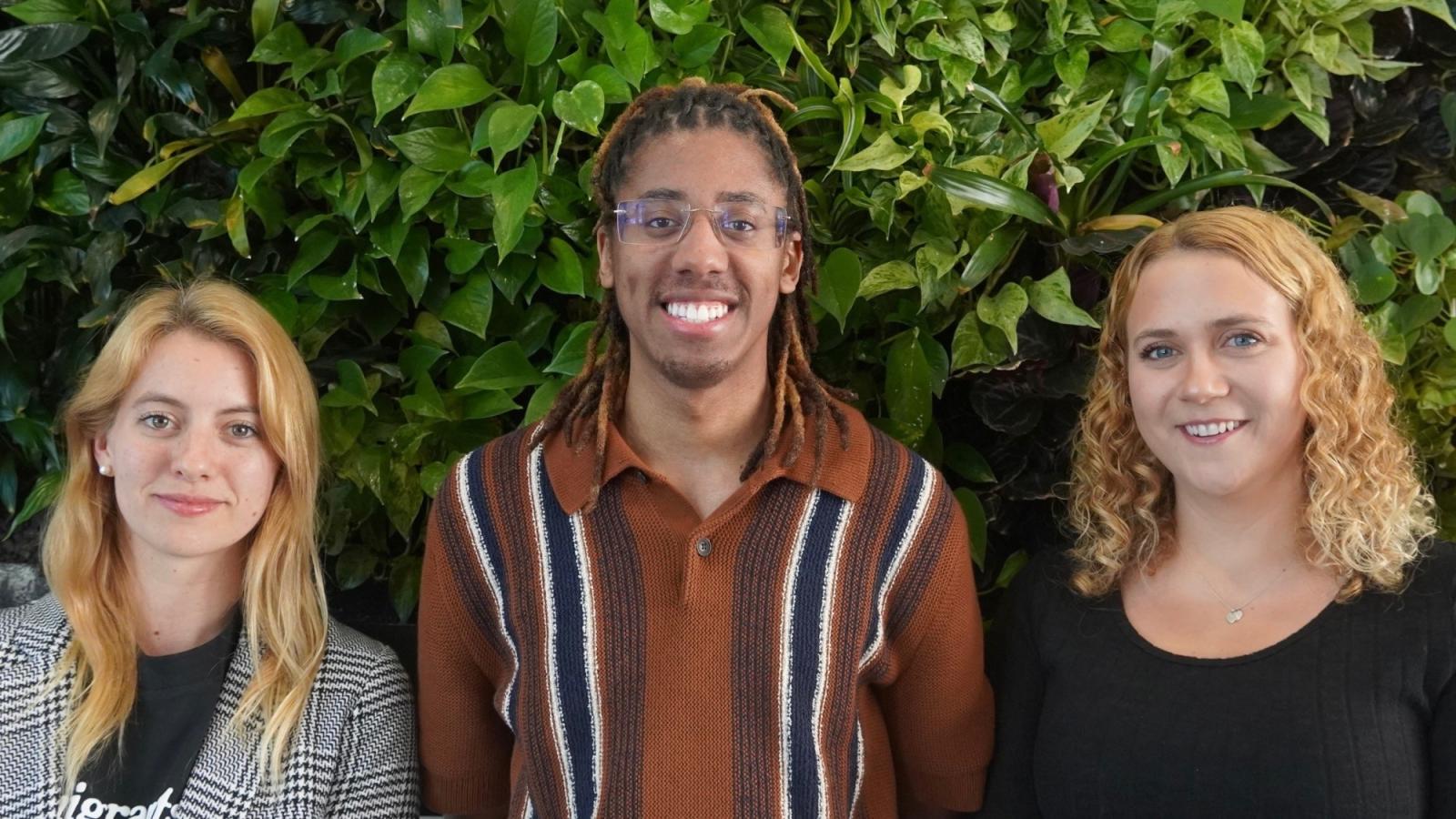
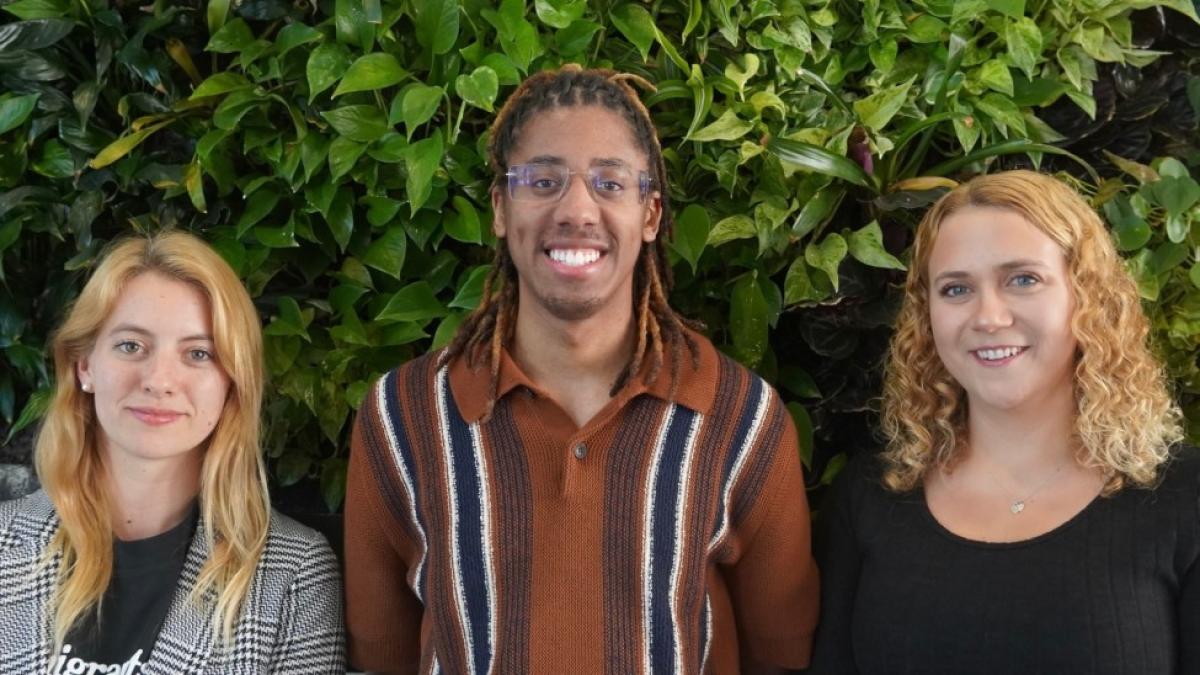
The Pace Energy and Climate Center (“PECC") is thrilled to announce the 2025–2026 Executive Board, which is comprised of three exceptional Elisabeth Haub School of Law at Pace University students committed to advancing PECC’s mission and outreach.
Frances Gothard ‘26 brings an invaluable global perspective to energy and environmental law using her background in International Studies along with her diverse experiences. At Pace Haub Law, she has served as the Co-Chair of the New Directions in Environmental Law Conference (“NDEL”) and as Vice President of the Environmental Law Society (“ELS”). Additionally, she worked as a research assistant for a collaborative law review article exploring the contours of environmental policy specifically on the legal landscapes surrounding natural resources, national parks, and national monuments. She also externed with Consolidated Edison Company of New York’s Energy and Environmental Law Department. Currently, she is practicing as a student attorney with the Food and Farm Business Law Clinic working with local small businesses and nonprofit organizations and serves as an editor for the national law journal The Urban Lawyer. Looking ahead, Frances is committed to elevating international perspectives on energy, food systems, and environmental policy to shape energy and climate law and advance equitable and sustainable energy and climate solutions.
Carington Lowe ‘26 has a background in science and brings an interdisciplinary approach to energy and environmental law. At Pace Haub Law, she serves as Co-Editor-in-Chief of the Pace Environmental Law Review, completed an externship with the Land Use Law Center, practiced as a student attorney in the Food and Farm Business Law Clinic, contributed as a research assistant on climate-conscious affordable housing, and serves as a Sustainable Business Law Hub Scholar. These experiences have shaped her commitment to advancing renewable energy transitions. Looking forward, Carington’s focus is on biofuel, nuclear energy, and identifying climate harm, with the goal of bridging science, technology, and policy to build a more equitable and sustainable energy future.
Kenneth Sumter ’26 is a creative professional driven by a deep passion for renewable energy. With a unique eye for design and storytelling, he channels his creativity into advancing clean energy solutions that connect people, places, and purpose. At PECC, his research this academic year focuses on reimagining urban battery storage to build a sustainable infrastructure dedicated to creating resilient cities and making affordable, reliable energy a reality for urban neighborhoods.
Under new leadership from its Executive Director Michael Hamersky and the ongoing expertise of Energy Policy Advisor Emma Lagle, PECC is driving innovative energy and environmental initiatives to tackle the planet’s most pressing climate and energy challenges. Student involvement is at the core of PECC, which is committed to an open-door policy that encourages all Pace Haub Law students to engage with the Center by getting involved in projects that spark their interest. Students will also be selected to serve as the Center's Energy and Climate Law Scholars and contribute to research, legal scholarship, and hands-on projects across the diverse initiatives of PECC. The Energy and Climate Law Scholars also have the opportunity to have their writing featured in the Center's newsletter: R.E.A.C.T. by PECC.
PECC also hosts student interns and externs, including Mercè Martí I Exposito LLM ‘26, Joseph Mayson LLM ‘26, and Clara Cusanelli ‘27, who are assisting with PECC’s innovative work on thermal energy networks, research related to sustainable biofuels, and international issues that PECC will address at IUCN and COP30.
